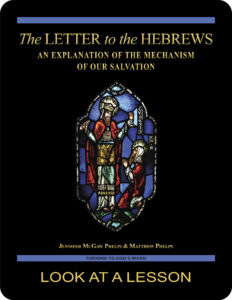consecrated / perfected
 The Letter to the Hebrews 10:14 (NABRE) contains an important description of Jesus’ priesthood: “For by one offering he has made perfect forever those who are being consecrated.” There’s a fascinating view of the difference between perfection and consecration as well as an interesting breakdown of the timing of each.
The Letter to the Hebrews 10:14 (NABRE) contains an important description of Jesus’ priesthood: “For by one offering he has made perfect forever those who are being consecrated.” There’s a fascinating view of the difference between perfection and consecration as well as an interesting breakdown of the timing of each.
The verb here referring to “perfection” is τελειόω (teleoo). The idea of perfection in Greek and Latin is that something is entirely finished or brought to its ultimate end. The verb here is in the perfect tense, which suggests something that has happened in the past and that continues to be true up until the present time—and potentially beyond. The important idea is that Christ achieved the work of perfecting or completing humanity at some point in the past that continues up through to today. Through the fall of humanity, there was something missing or incomplete up until Christ.
The idea of “consecration” in this passage uses the Greek verb ἁγιάζω (agiazo), which just as easily could be translated as “make holy.” It contains the root meaning of the concept of holiness that things are set apart or separate. The translation of this does a good job capturing its sense of time. This is a present tense view of those who are being sanctified or made holy. This phrase suggests that although humanity has in aggregate been completed in the past, we still bear individual responsibility to realize the gift of that perfection and to sanctify ourselves. Christ’s offering gives each of us the opportunity for holiness and leaves us with the responsibility of claiming that gift.
you also may like our study of the Letter to the Hebrews (digital only)
 Many Christians struggle to understand one of the central mysteries of our faith: how Jesus can be both human and divine at the same time. The Letter to the Hebrews: An Explanation of the Mechanism of Our Salvation, an 18-lesson Catholic Bible study with an imprimatur, offers an in-depth look at the way in which Jesus’ dual nature allows for the salvation of humanity. The Letter to the Hebrews is designed to provide information that will encourage Christians to remain faithful. Click on the book’s cover to view a sample lesson.
Many Christians struggle to understand one of the central mysteries of our faith: how Jesus can be both human and divine at the same time. The Letter to the Hebrews: An Explanation of the Mechanism of Our Salvation, an 18-lesson Catholic Bible study with an imprimatur, offers an in-depth look at the way in which Jesus’ dual nature allows for the salvation of humanity. The Letter to the Hebrews is designed to provide information that will encourage Christians to remain faithful. Click on the book’s cover to view a sample lesson.
 Click on the picture of the statue of Moses with horns (above) to learn more about Lost in Translation. A new entry is archived each Monday. Contact us to receive Lost in Translation by email every week. You may use any of the contact links on our website to ask Matthew a question.
Click on the picture of the statue of Moses with horns (above) to learn more about Lost in Translation. A new entry is archived each Monday. Contact us to receive Lost in Translation by email every week. You may use any of the contact links on our website to ask Matthew a question.
